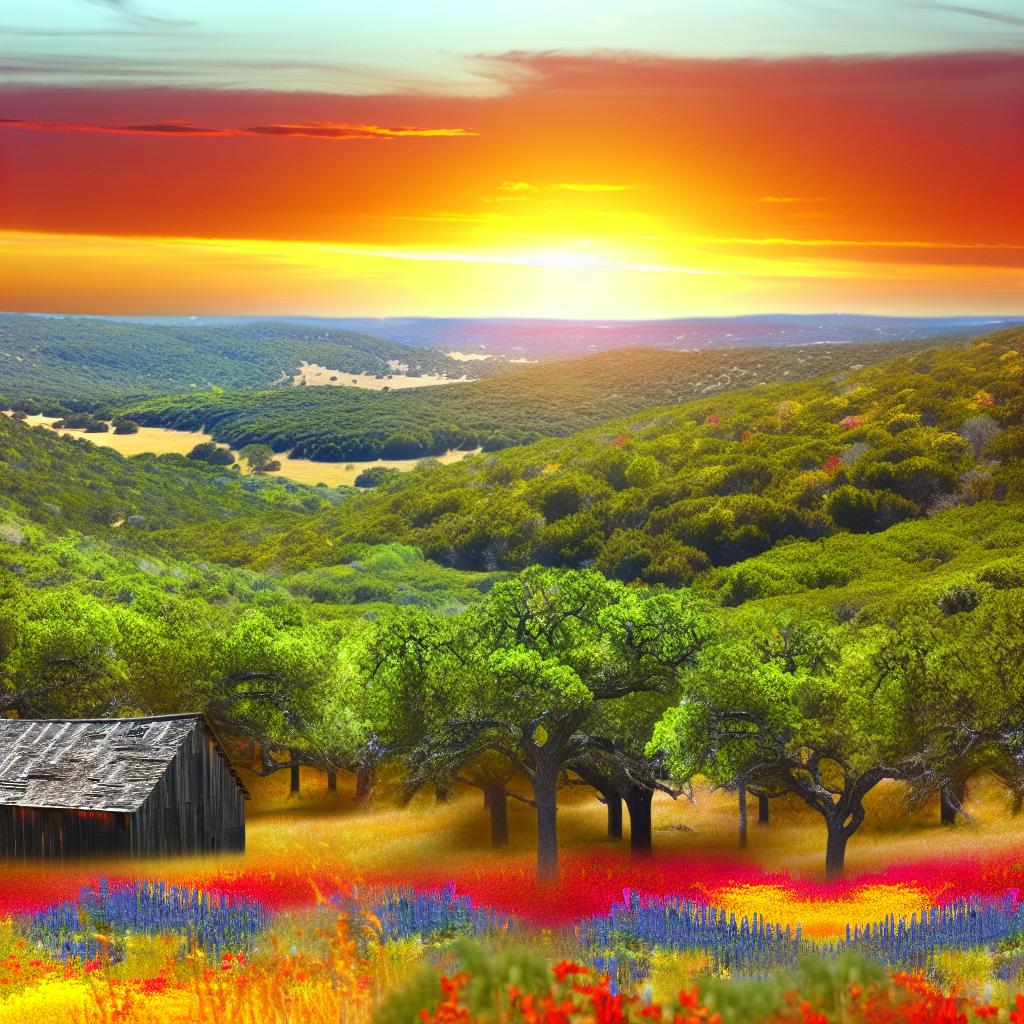The Unique Geography and Climate of the Texas Hill Country
The Texas Hill Country, located in Central Texas, is renowned for its rugged terrain, rolling hills, and diverse natural beauty. This region, characterized by its limestone and granite formations, creates a unique environment that supports a wide variety of flora and fauna. The climate in the Hill Country boasts hot summers and mild winters, making it conducive for a range of agricultural activities and outdoor pursuits.
Rich Biodiversity and Native Flora
A critical aspect of the Texas Hill Country is its impressive biodiversity, which is supported by the distinctive geological features and climate conditions prevalent in the region. The limestone hills and varying altitudes create microenvironments that help sustain an array of plant life. The Texas Bluebonnet is perhaps the most famous wildflower in the area, celebrated for its vibrant blue color and contribution to the region’s picturesque landscapes during the spring.
Aside from its emblematic wildflowers, the region’s flora includes the resilient Live Oak and the drought-resistant Ashe Juniper. These trees play an essential role in maintaining the ecological balance, providing habitat and food for various animal species, and proving instrumental in water retention and soil stability. Their resilience to the region’s environmental conditions ensures they flourish where other types of vegetation might struggle.
The intertwining of flora and fauna in the Texas Hill Country creates ecosystems that are home to a variety of wildlife. This includes numerous bird species, small mammals, and some endangered species, which rely on the native plants for sustenance and shelter. The symbiotic relationships among the land’s flora and fauna highlight the importance of conservation efforts to maintain the delicate ecological balance.
Water Resources and Aquifers
Water is a precious commodity in the Texas Hill Country, and the region’s complex network of rivers, streams, and aquifers illustrates its vital role in supporting both human activity and natural habitats. Major aquifers, notably the Edwards Aquifer and the Trinity Aquifer, serve as crucial water resources for the Central Texas region. These aquifers are pivotal in providing clean water to countless residents, agriculture, and industry, emphasizing the need for conscientious management and conservation.
The area’s rivers, such as the Guadalupe and the Colorado, offer much more than water resources for human consumption and agriculture. They act as lifelines for surrounding ecosystems, sustaining aquatic plants and animals and maintaining habitats for countless species. These water bodies also provide outstanding recreational opportunities, ranging from fishing and boating to swimming and kayaking. Their scenic beauty enhances the appeal of the Texas Hill Country as a destination for nature lovers and adventurers.
The interplay between the Texas Hill Country’s water resources and its land plays a vital role in shaping the region’s unique landscapes. The importance of preserving these resources cannot be overstated, as they are fundamental to the region’s continued sustainability and vitality.
Agriculture and Vineyards
The Texas Hill Country is ripe with agricultural opportunities due to its distinctive soil and climate conditions. The region is characterized by its limestone-rich, well-drained soils. These conditions are highly favorable for certain crops and have provided the foundation for a thriving agricultural industry.
In recent years, the Hill Country has gained notoriety for its burgeoning wine industry, with local vineyards cultivating grapes that produce wines of increasing quality and recognition. The combination of strong sunlight, moderate rainfall, and unique soil composition creates an ideal environment for viticulture, prompting a growing number of vineyards to establish themselves in the region and offering wine enthusiasts diverse tasting experiences.
Beyond vineyards, the region’s agricultural landscape is rich with the cultivation of other crops. Peaches are prominently grown, treasured for their sweetness, as are olives, which benefit from the region’s Mediterranean-like climate. Together, these crops make the Hill Country a significant contributor to Texas’ agricultural output, connecting traditional farming practices with new opportunities in specialty crop production.
Tourism and Economic Impact
Tourism significantly contributes to the economy of the Texas Hill Country. The area’s natural beauty attracts visitors year-round, drawn by the outdoor recreational activities, unique landscapes, and cultural richness. Hiking and camping in the vast landscapes provide visitors access to the region’s unspoiled beauty, while bird-watching enthusiasts can find a multitude of species drawn to the Hill Country’s varied habitats.
Beyond the allure of its outdoor spaces, the Texas Hill Country offers a rich tapestry of cultural events and festivals. The area hosts numerous music festivals, art exhibitions, and historical events annually, reflecting its deep-rooted cultural heritage and lively community spirit. These events attract not only locals but also visitors from across the country, enhancing the region’s reputation as a hub of cultural diversity and engagement.
The combined impact of tourism and agriculture underpins much of the economic activity in the Hill Country. Whether through agritourism, which connects visitors to wineries and farms, or through the hosting of cultural happenings and festivals, these economic drivers form the backbone of the region’s continued prosperity.
Preservation and Conservation Efforts
Preservation of the Texas Hill Country’s natural and cultural resources is imperative for its continued success. Various local and state organizations are actively engaged in conservation initiatives aimed at protecting the Hill Country’s unique biodiversity. These efforts include everything from habitat restoration projects to programs promoting sustainable agricultural and tourism practices.
Understanding the susceptibility of the region to issues like water scarcity and land degradation, stakeholders focus on sustainable practices that ensure resources are maintained for future generations. Education and community involvement are key components of these efforts, fostering a culture of conservation and environmental stewardship among residents and visitors alike.
The potential of the Texas Hill Country to continue thriving lies in the balance between economic development and conservation. By safeguarding its natural beauty and resources, the region not only secures its environmental health but also bolsters its appeal as a premier destination for nature and culture enthusiasts alike.
For further exploration of the Texas Hill Country, visiting the Texas Hill Country official site provides additional insights and information on this remarkable region.


